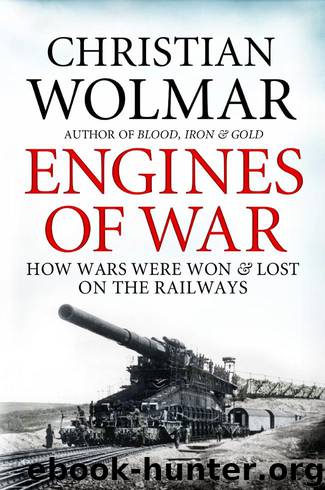Engines of War: How Wars Were Won & Lost on the Railways by Christian Wolmar

Author:Christian Wolmar [Wolmar, Christian]
Language: eng
Format: mobi
Tags: Non-Fiction, Engineering, World, History
ISBN: 9780857891396
Publisher: Atlantic Books
Published: 2010-09-30T16:00:00+00:00
EIGHT
EASTERN CONTRASTS
On the Eastern Front and in other theatres which were brought into action in the later stages of the war, a very different type of conflict took place. The Schlieffen Plan had been devised in an effort to avoid the risk of fighting simultaneously on two fronts, but the failure of diplomacy and the rush into war guaranteed that Germany was plunged into this unwanted scenario. Unlike on the Western Front, where a stalemate emerged within weeks of the outbreak of war, in the East it was the absence of railways which resulted in a more mobile war. According to A. J. P. Taylor, ‘an attacking force could advance fifty miles or so if carefully reinforced. Then the impetus of advance gave out, through lack of railways. The defenders, falling back on their supplies, consolidated their position: the line formed anew.’1
The Russians rushed into the war, somewhat unprepared, on 17 August 1914 in order to support their Western allies. Despite German expectations, the Russian forces mobilized reasonably quickly, though not in sufficient numbers to give them a decisive advantage. Their mobilization plans included the requirement that freight trains should cease to run while the troops were deployed but, in the event, according to Westwood, ‘the Russian railways did so well that they found capacity to restore their freight trains to service, rather sheepishly reloading the freight that had been jettisoned at wayside stations a couple of weeks earlier’.2 This episode is typical of the Russian performance in the whole war, which was patchy, with surprisingly efficient episodes interspersed with others that had all the hallmarks of the inefficient and corrupt tsarist regime and its total disregard for the fate of the foot soldiers. While Russian industrialization had not really taken off by 1914, ensuring its army was short of equipment, the sheer numbers the military could muster, together with the scale of the country, guaranteed that Russia was able to put up stern resistance to the Central Powers, especially as it mostly faced the weaker of the two, the Austro-Hungarian Empire, across the battlefield in the initial stages. Moreover, Russia was industrializing fast, which meant that by the middle of the war it was better able to supply its troops with sufficient guns and ammunition. Russian logistics were hampered, though, by the kind of muddle which had characterized the French handling of the Franco-Prussian War. The railways were split, as in France, between those near the front, which were under military control, and the lines in the interior, which remained the responsibility of the ministry of transport. The usual mistakes were made with railway and military authorities squabbling over what trains should have priority, and officers refusing to co-operate by holding on to wagons, once they had been unloaded, for use as warehouses, offices or even living quarters.
The war was launched when two Russian armies pushed, with little clear intent, into East Prussia. After some hesitation, and an initial retreat which led to the replacement of their commander, the
Download
This site does not store any files on its server. We only index and link to content provided by other sites. Please contact the content providers to delete copyright contents if any and email us, we'll remove relevant links or contents immediately.
Small Unmanned Fixed-wing Aircraft Design by Andrew J. Keane Andras Sobester James P. Scanlan & András Sóbester & James P. Scanlan(32141)
Navigation and Map Reading by K Andrew(4553)
Endurance: Shackleton's Incredible Voyage by Alfred Lansing(3840)
Wild Ride by Adam Lashinsky(1658)
And the Band Played On by Randy Shilts(1615)
The Box by Marc Levinson(1595)
Top 10 Prague (EYEWITNESS TOP 10 TRAVEL GUIDES) by DK(1567)
The Race for Hitler's X-Planes: Britain's 1945 Mission to Capture Secret Luftwaffe Technology by John Christopher(1526)
The One Percenter Encyclopedia by Bill Hayes(1463)
Girls Auto Clinic Glove Box Guide by Patrice Banks(1362)
Trans-Siberian Railway by Lonely Planet(1342)
Looking for a Ship by John McPhee(1320)
Fighting Hitler's Jets: The Extraordinary Story of the American Airmen Who Beat the Luftwaffe and Defeated Nazi Germany by Robert F. Dorr(1300)
Batavia's Graveyard by Mike Dash(1300)
Troubleshooting and Repair of Diesel Engines by Paul Dempsey(1284)
Bligh by Rob Mundle(1273)
TWA 800 by Jack Cashill(1253)
The Great Halifax Explosion by John U. Bacon(1229)
Ticket to Ride by Tom Chesshyre(1228)
